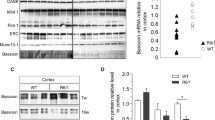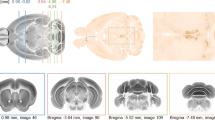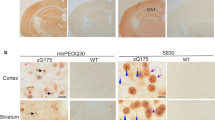Abstract
The anti-serum against an unknown human placental antigen complex X-P2 (hPAX-P2) immunohistochemically recognizes three putative molecules (hPAX-P2S, hPAX-P2N, and hPAX-P2R), each of which is associated with the stigmoid bodies (STBs), necklace olfactory glomeruli (NOGs), or reticulo-filamentous structures (RFs) in the rat brain. The STBs also contain huntingtin-associated protein 1 (HAP1), and the HAP1-cDNA transfection induces STB-like inclusions in cultured cells. In order to clarify the relationship between hPAX-P2S and HAP1 isoforms (A/B), we performed Western blotting, immuno-histo/cytochemistry for light- and electron-microscopy and pre-adsorption tests with HAP1 deletion fragments. The results showed that the anti-hPAX-P2 anti-serum recognizes HAP1474–577 of HAP1A/B in Western blotting and strongly immunostains HAP1A-induced STB-like inclusions but far weakly detects HAP1B-induced diffuse structures in HAP1-transfected HEK 293 cells. In the rat brain, immunoreactivity of the anti-hPAX-P2 anti-serum for the STBs was eliminated by pre-adsorption with HAP1474–577, whereas no pre-adsorption with any different HAP1 fragments can suppress immunoreactivity for the NOGs and RFs, which were not immunoreactive to anti-HAP1 anti-serum. These findings indicate that hPAX-P2S, which is distinct from hPAX-P2N and hPAX-P2R, is identical with STB-constituted HAP1 and that the HAP1-induced/immunoreactive inclusions correspond to the hPAX-P2-immunoreactive STBs previously identified in the brain.







Similar content being viewed by others
References
Chan EY, Nasir J, Gutekunst CA, Coleman S, Maclean A, Maas A, Metzler M, Gertsenstein M, Ross CA, Nagy A, Hayden MR (2002) Targeted disruption of huntingtin-associated protein-1 (Hap1) results in postnatal death due to depressed feeding behavior. Hum Mol Genet 11:945–959
Dragatsis I, Dietrich P, Zeitlin S (2000) Expression of the huntingtin-associated protein 1 gene in the developing and adult mouse. Neurosci Lett 282:37–40
Dragatsis I, Zeitlin S, Dietrich P (2004) Huntingtin-associated protein-1 (Hap1) mutant mice bypassing the early postnatal lethality are neuroanatomically normal and fertile but display growth retardation. Hum Mol Genet 13:3115–3125
Fletcher PJ, Korth KM, Sabijan MS, DeSousa NJ (1998) Injections of D-amphetamine into the ventral pallidum increase locomotor activity and responding for conditioned reward: a comparison with injections into the nucleus accumbens. Brain Res 805:29–40
Fujinaga R, Kawano J, Matsuzaki Y, Kamei K, Yanai A, Sheng Z, Tanaka M, Nakahama K, Nagano M, Shinoda K (2004) Neuroanatomical distribution of huntingtin-associated protein 1-mRNA in the male mouse brain. J Comp Neurol 478:88–109
Fujinaga R, Takeshita Y, Yoshida K, Kametani Y, Nakatsuka H, Yanai A, Shinoda K (2005) Comparative distributions of huntingtin-associated protein 1 (HAP1) and androgen receptor (AR) in the rat brain and their functional interaction in vitro. Acta Histochem Cytochem 38:514 (IA11) [Abstract]
Gong W, Neill D, Justice JB Jr (1996) Conditioned place preference and locomotor activation produced by injection of psychostimulants into ventral pallidum. Brain Res 707:64–74
Gong W, Neill D, Justice JB Jr (1997a) 6-Hydroxydopamine lesion of ventral pallidum blocks acquisition of place preference conditioning to cocaine. Brain Res 754:103–112
Gong W, Justice JB Jr, Neill D (1997b) Dissociation of locomotor and conditioned place preference responses following manipulation of GABA-A and AMPA receptors in ventral pallidum. Prog Neuropsychopharmacol Biol Psychiatry 21:839–852
Greer CA, Stewart WB, Kauer JS, Shepherd GM (1981) Topographical and laminar localization of 2-deoxyglucose uptake in rat olfactory bulb induced by electrical stimulation of olfactory nerves. Brain Res 217:279–293
Gutekunst CA, Li SH, Yi H, Ferrante RJ, Li XJ, Hersch SM (1998) The cellular and subcellular localization of huntingtin-associated protein 1 (HAP1): comparison with huntingtin in rat and human. J Neurosci 18:7674–7686
Hodgson JG, Agopyan N, Gutekunst CA, Leavitt BR, LePiane F, Singaraja R, Smith DJ, Bissada N, McCutcheon K, Nasir J, Jamot L, Li XJ, Stevens ME, Rosemond E, Roder JC, Phillips AG, Rubin EM, Hersch SM, Hayden MR (1999) A YAC mouse model for Huntington’s disease with full-length mutant huntingtin, cytoplasmic toxicity, and selective striatal neurodegeneration. Neuron 23:181–192
Johnson PI, Stellar JR, Paul AD (1993) Regional reward differences within the ventral pallidum are revealed by microinjections of a mu opiate receptor agonist. Neuropharmacology 32:1305–1314
Kamei K, Matsuzaki Y, Hanada K, Nagano M, Nakahama K, Shinoda K (2001) Distribution of HAP1 mRNA in the rat brain. Acta Anat Nippon 76:88 (A91) [Abstract]
Kittler JT, Thomas P, Tretter V, Bogdanov YD, Haucke V, Smart TG, Moss SJ (2004) Huntingtin-associated protein 1 regulates inhibitory synaptic transmission by modulating gamma-aminobutyric acid type A receptor membrane trafficking. Proc Natl Acad Sci USA 101:12736–12741
Koga M, Fujinaga R, Shinoda K (2002) Interaction between HAP1 and polyglutamine protein in vitro. In: Proccedings of the 57th Chugoku-Shikoku conference of Japanese association of anatomists. Yonago, Japan, p 13, 9 November [Abstract]
Li XJ, Li SH (2005) HAP1 and intracellular trafficking. Trends Pharmacol Sci 26:1–3
Li XJ, Li SH, Sharp AH, Nucifora FC, Schilling G, Lanahan A, Worley P, Snyder SH, Ross CA (1995) A huntingtin-associated protein enriched in brain with implications for pathology. Nature 378:398–402
Li SH, Gutekunst CA, Hersch SM, Li XJ (1998a) Association of HAP1 isoforms with a unique cytoplasmic structure. J Neurochem 71:2178–2185
Li SH, Gutekunst CA, Hersch SM, Li XJ (1998b) Interaction of huntingtin-associated protein with dynactin P150Glued. J Neurosci 18:1261–1269
Li SH, Hosseini SH, Gutekunst CA, Hersch SM, Ferrante RJ, Li XJ (1998c) A human HAP1 homologue. J Biol Chem 273:19220–19227
Li SH, Yu ZX, Li CL, Nguyen HP, Zhou YX, Deng C, Li XJ (2003) Lack of huntingtin-associated protein-1 causes neuronal death resembling hypothalamic degeneration in Huntington’s disease. J Neurosci 23:6956–6964
Marcora E, Gowan K, Lee JE (2003) Stimulation of NeuroD activity by huntingtin and huntingtin-associated proteins HAP1 and MLK2. Proc Natl Acad Sci USA 100:9578–9583
McAlonan GM, Robbins TW, Everitt BJ (1993) Effects of medial dorsal thalamic and ventral pallidal lesions on the acquisition of a conditioned place preference: further evidence for the involvement of the ventral striatopallidal system in reward-related processes. Neuroscience 52:605–620
McGuire JR, Rong J, Li SH, Li XJ (2006) Interaction of huntingtin-associated protein-1 with kinesin light chain: implications in intracellular trafficking in neurons. J Biol Chem 281:3552–3559
Nagano M, Shinoda K (1994) Coexistence of the stigmoid body and estrogen receptor in some neuronal groups involved in rat reproductive functions. Brain Res 634:296–304
Osawa Y, Higashiyama T (1980) Isolation of human placental cytochrome P-450 and its mechanism of action of androgen aromatization. In: Coon MJ, et al (eds) Microsomes, drug oxidations, and chemical carcinogenesis, vol 1. Academic, New York, pp 225–228
Osawa Y, Nakamura T (1982) Anti-human placental aromatase II cytochrome P-450 antibody and immunohistochemical study of estrogen biosynthesis. Endocrinology 110:81 (A31) [Abstract]
Osawa Y, Tochigi B, Higashiyama T (1978) Two different androgen aromatases in human placenta. Aromatase I for estradiol and aromatase II for estrone formation. Endocrinolory 102 (A222) [Abstract]
Page KJ, Potter L, Aronni S, Everitt BJ, Dunnett SB (1998) The expression of Huntingtin-associated protein (HAP1) mRNA in developing, adult and ageing rat CNS: implications for Huntington’s disease neuropathology. Eur J Neurosci 10:1835–1845
Panagis G, Spyraki C (1996) Neuropharmacological evidence for the role of dopamine in ventral pallidum self-stimulation. Psychopharmacology (Berl) 123:280–288
Panov AV, Gutekunst CA, Leavitt BR, Hayden MR, Burke JR, Strittmatter WJ, Greenamyre JT (2002) Early mitochondrial calcium defects in Huntington’s disease are a direct effect of polyglutamines. Nat Neurosci 5:731–736
Paxinos G, Watson C (1998) The rat brain in stereotaxic coordinates, 4th edn. Academic, San Diego
Rahman MS, Yanai K, Kawata K, Okumura T, Shinoda K (1999) Structural analysis of the Mab 213-immunoreactive “Necklace glomeruli” in the rat primary olfactory system. Bull Yamaguchi Med Sch 46:23–32
Ring G, Mezza RC, Schwob JE (1997) Immunohistochemical identification of discrete subsets of rat olfactory neurons and the glomeruli that they innervate. J Comp Neurol 388:415–434
Rong J, McGuire JR, Fang ZH, Sheng G, Shin JY, Li XJ (2006) Regulation of intracellular trafficking of huntingtin-associated protein 1 is critical for TrkA protein levels and neurite outgrowth. J Neurosci 26:6019–6030
Rong J, Li SH, Li XJ (2007a) Regulation of intracellular HAP1 trafficking. J Neurosci Res doi:10.1002/jnr.21326
Rong J, Li S, Sheng G, Wu M, Coblitz B, Li M, Fu H, Li XJ (2007b) 14-3-3 protein interacts with huntingtin-associated protein 1 and regulates its trafficking. J Biol Chem 282:4748–4756
Sheng Z, Yanai A, Fujinaga R, Kawano J, Tanaka M, Watanabe Y, Shinoda K (2003) Gonadal and adrenal effects on the glucocorticoid receptor in the rat hippocampus, with special reference to regulation by estrogen from an immunohistochemical view-point. Neurosci Res 46:205–218
Sheng Z, Kawano J, Yanai A, Fujinaga R, Tanaka M, Watanabe Y, Shinoda K (2004) Expression of estrogen receptors (alpha, beta) and androgen receptor in serotonin neurons of the rat and mouse dorsal raphe nuclei; sex and species differences. Neurosci Res 49:185–196
Sheng G, Chang G, Lin JY, Yu ZX, Fang ZH, Rong J, Lipton SA, Li SH, Tong G, Leibowitz SF, Li XJ (2006) Hypothalamic huntingtin-associated protein 1 as a mediator of feeding behavior. Nat Med 5:526–633
Shimura T, Imaoka H, Yamamoto T (2006) Neurochemical modulation of ingestive behavior in the ventral pallidum. Eur J Neurosci 23:1596–1560
Shinoda K, Shiotani Y, Osawa Y (1989a) “Necklace olfactory glomeruli” form unique components of the rat primary olfactory system. J Comp Neurol 284:362–515
Shinoda K, Yagi H, Fujita Y, Osawa Y, Shiotani Y (1989b) Screening of aromatase-containing neurons in rat forebrain: an immunohistochemical study with antibody against the human placental antigen X-P2 (hPAX-P2). J Comp Neurol 290:502–515
Shinoda K, Yagi H, Osawa Y, Shiotani Y (1990) Involvement of specific placental antigen X-P2 in rat olfaction: an immunohistochemical study in the olfactory bulb. J Comp Neurol 294:340–344
Shinoda K, Mori S, Ohtsuki T, Osawa Y (1992) An aromatase-associated cytoplasmic inclusion, the “stigmoid body,” in the rat brain: I. Distribution in the forebrain. J Comp Neurol 322:360–376
Shinoda K, Nagano M, Osawa Y (1993a) An aromatase-associated cytoplasmic inclusion, the “stigmoid body,” in the rat brain: II. Ultrastructure (with a review of its history and nomenclature). J Comp Neurol 329:1–19
Shinoda K, Ohtsuki Y, Nagano M, Okumura T (1993b) A possible functional necklace formed by placental antigen X-P2-immunoreactive and intensely acetylcholinesterase-reactive (PAX/IAE) glomerular complexes in the rat olfactory bulb. Brain Res 618:160–166
Shinoda K, Nagano M, Osawa Y (1994) Neuronal aromatase expression in preoptic, strial, and amygdaloid regions during late prenatal and early postnatal development in the rat. J Comp Neurol 343:113–129
Stratford TR, Kelley AE, Simansky KJ (1999) Blockade of GABAA receptors in the medial ventral pallidum elicits feeding in satiated rats. Brain Res 825:199–203
Takeshita Y, Fujinaga R, Zhao C, Yanai A, Shinoda K (2006) Huntingtin-associated protein 1 (HAP1) interacts with androgen receptor (AR) and suppresses SBMA-mutant-AR-induced apoptosis. Hum Mol Genet 15:2298–2342
Tang TS, Tu H, Chan EY, Maximov A, Wang Z, Wellington CL, Hayden MR, Bezprozvanny I (2003) Huntingtin and huntingtin-associated protein 1 influence neuronal calcium signaling mediated by inositol-(1,4,5) triphosphate receptor type 1. Neuron 39:227–239
Tang TS, Tu H, Orban PC, Chan EY, Hayden MR, Bezprozvanny I (2004) HAP1 facilitates effects of mutant huntingtin on inositol 1,4,5-trisphosphate-induced Ca release in primary culture of striatal medium spiny neurons. Eur J Neurosci 20:1779–1787
Teicher MH, Stewart JS, Kauer JS, Shepherd GM (1980) Suckling phenomenon stimulation of a modified glomerular region in the developing rat olfactory bulb revealed by the 2-deoxyglucose method. Brain Res 194:530–535
Tindell AJ, Berridge KC, Aldridge JW (2004) Ventral pallidal representation of pavlovian cues and reward: population and rate codes. J Neurosci 24:1058–1069
Young LJ, Lim MM, Gingrich B, Insel TR (2001) Cellular mechanisms of social attachment. Horm Behav 40:133–138
Zhao C, Fujinaga R, Tanaka M, Yanai A, Nakahama K, Shinoda K (2007) Region-specific expression and sex-steroidal regulation on aromatase and its mRNA in the male rat brain: immunohistochemical and in situ hybridization analyses. J Comp Neurol 500:557–573
Acknowledgments
This study was supported by Grant-in-Aids for Young Scientists (B) (No. 17700333) and for Scientific Research on Priority Areas (No.17052016) from the Ministry of Education, Culture, Sports, Science, and Technology (MEXT) and a Grant-in-Aid for Scientific Research (C) (No.17500231) from the Japan Society for the Promotion of Science (JSPS). We cordially thank Prof. Yoshio Osawa (Hauptman-Wookward Medical Research Institute Inc., Buffalo, NY, USA) for gifting us anti-hPAX-P2 anti-serum. We are grateful to Mr. Chikahisa Matsuo, Mr. Jun Oba, and Mrs. Yumiko Matsuzaki for their technical assistance and administrative helps with this work, and to Dr. Ken-ichi Nakahama for his excellent technical help in the early stages of the present study. We would also like to acknowledge the technical expertise of the Institute for Biomedical Research and Education, Yamaguchi University Science Research Center and the DNA Core facility of the Center for Gene Research, Yamaguchi University, supported by a Grant-in-Aid from the Ministry of Education, Science, Sports, and Culture of Japan.
Author information
Authors and Affiliations
Corresponding author
Rights and permissions
About this article
Cite this article
Fujinaga, R., Yanai, A., Nakatsuka, H. et al. Anti-human placental antigen complex X-P2 (hPAX-P2) anti-serum recognizes C-terminus of huntingtin-associated protein 1A common to 1B as a determinant marker for the stigmoid body. Histochem Cell Biol 128, 335–348 (2007). https://doi.org/10.1007/s00418-007-0315-5
Received:
Accepted:
Published:
Issue Date:
DOI: https://doi.org/10.1007/s00418-007-0315-5




